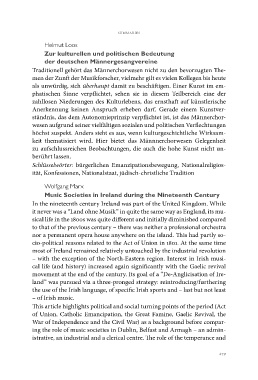Page 481 - Weiss, Jernej, ur./ed. 2023. Glasbena društva v dolgem 19. stoletju: med ljubiteljsko in profesionalno kulturo ▪︎ Music societies in the long 19th century: Between amateur and professional culture. Koper/Ljubljana: Založba Univerze na Primorskem in Festival Ljubljana. Studia musicologica Labacensia, 6
P. 481
summaries
Helmut Loos
Zur kulturellen und politischen Bedeutung
der deutschen Männergesangvereine
Traditionell gehört das Männerchorwesen nicht zu den bevorzugten The-
men der Zunft der Musikforscher, vielmehr gilt es vielen Kollegen bis heute
als unwürdig, sich überhaupt damit zu beschäftigen. Einer Kunst im em-
phatischen Sinne verpflichtet, sehen sie in diesem Teilbereich eine der
zahllosen Niederungen des Kulturlebens, das ernsthaft auf künstlerische
Anerkennung keinen Anspruch erheben darf. Gerade einem Kunstver-
ständnis, das dem Autonomieprinzip verpflichtet ist, ist das Männerchor-
wesen aufgrund seiner vielfältigen sozialen und politischen Verflechtungen
höchst suspekt. Anders sieht es aus, wenn kulturgeschichtliche Wirksam-
keit thematisiert wird. Hier bietet das Männnerchorwesen Gelegenheit
zu aufschlussreichen Beobachtungen, die auch die hohe Kunst nicht un-
berührt lassen.
Schlüsselwörter: bürgerlichen Emanzipationsbewegung, Nationalreligios-
ität, Konfessionen, Nationalstaat, jüdisch-christliche Tradition
Wolfgang Marx
Music Societies in Ireland during the Nineteenth Century
In the nineteenth century Ireland was part of the United Kingdom. While
it never was a “Land ohne Musik” in quite the same way as England, its mu-
sical life in the 1800s was quite different and initially diminished compared
to that of the previous century – there was neither a professional orchestra
nor a permanent opera house anywhere on the island. This had partly so-
cio-political reasons related to the Act of Union in 1801. At the same time
most of Ireland remained relatively untouched by the industrial revolution
– with the exception of the North-Eastern region. Interest in Irish musi-
cal life (and history) increased again significantly with the Gaelic revival
movement at the end of the century. Its goal of a “De-Anglicisation of Ire-
land” was pursued via a three-pronged strategy: reintroducing/furthering
the use of the Irish language, of specific Irish sports and – last but not least
– of Irish music.
This article highlights political and social turning points of the period (Act
of Union, Catholic Emancipation, the Great Famine, Gaelic Revival, the
War of Independence and the Civil War) as a background before compar-
ing the role of music societies in Dublin, Belfast and Armagh – an admin-
istrative, an industrial and a clerical centre. The role of the temperance and
479
Helmut Loos
Zur kulturellen und politischen Bedeutung
der deutschen Männergesangvereine
Traditionell gehört das Männerchorwesen nicht zu den bevorzugten The-
men der Zunft der Musikforscher, vielmehr gilt es vielen Kollegen bis heute
als unwürdig, sich überhaupt damit zu beschäftigen. Einer Kunst im em-
phatischen Sinne verpflichtet, sehen sie in diesem Teilbereich eine der
zahllosen Niederungen des Kulturlebens, das ernsthaft auf künstlerische
Anerkennung keinen Anspruch erheben darf. Gerade einem Kunstver-
ständnis, das dem Autonomieprinzip verpflichtet ist, ist das Männerchor-
wesen aufgrund seiner vielfältigen sozialen und politischen Verflechtungen
höchst suspekt. Anders sieht es aus, wenn kulturgeschichtliche Wirksam-
keit thematisiert wird. Hier bietet das Männnerchorwesen Gelegenheit
zu aufschlussreichen Beobachtungen, die auch die hohe Kunst nicht un-
berührt lassen.
Schlüsselwörter: bürgerlichen Emanzipationsbewegung, Nationalreligios-
ität, Konfessionen, Nationalstaat, jüdisch-christliche Tradition
Wolfgang Marx
Music Societies in Ireland during the Nineteenth Century
In the nineteenth century Ireland was part of the United Kingdom. While
it never was a “Land ohne Musik” in quite the same way as England, its mu-
sical life in the 1800s was quite different and initially diminished compared
to that of the previous century – there was neither a professional orchestra
nor a permanent opera house anywhere on the island. This had partly so-
cio-political reasons related to the Act of Union in 1801. At the same time
most of Ireland remained relatively untouched by the industrial revolution
– with the exception of the North-Eastern region. Interest in Irish musi-
cal life (and history) increased again significantly with the Gaelic revival
movement at the end of the century. Its goal of a “De-Anglicisation of Ire-
land” was pursued via a three-pronged strategy: reintroducing/furthering
the use of the Irish language, of specific Irish sports and – last but not least
– of Irish music.
This article highlights political and social turning points of the period (Act
of Union, Catholic Emancipation, the Great Famine, Gaelic Revival, the
War of Independence and the Civil War) as a background before compar-
ing the role of music societies in Dublin, Belfast and Armagh – an admin-
istrative, an industrial and a clerical centre. The role of the temperance and
479


